This post is sponsored by Neostrata.
Neostrata is a cult brand amongst skincare nerds, and for good reason – it’s the brand that doctors Eugene Van Scott and Ruey Yu started after they discovered the skin-rejuvenating properties of alpha hydroxy acids (AHAs) like glycolic acid and lactic acid in the 1970s. Thanks to their pioneering work, AHAs are now the most commonplace chemical exfoliants you’ll see in skincare.
Since then, they’ve also discovered two new generations of hydroxy acids which have similar actions to the original AHAs, but with extra benefits: polyhydroxy acids and bionic polyhydroxy acids.
Today I’m going to be talking about Neostrata’s Skin Active Tri-Therapy Lifting Serum, which contains three star ingredients: 8% gluconolactone (a polyhydroxy acid), 1.25% Aminofil and 0.5% low molecular weight hyaluronic acid. These three ingredients work together to give skin a lifted look.
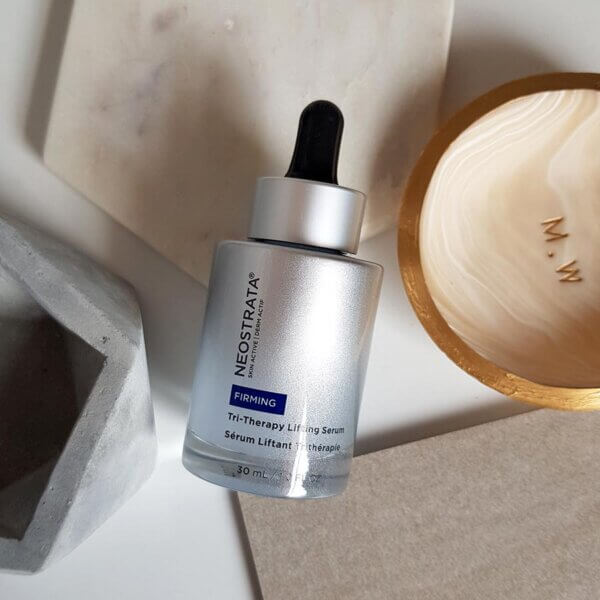
Polyhydroxy acids
Polyhydroxy acids or PHAs are, as you’ve probably guessed, are related to alpha hydroxy acids (AHAs). But while AHAs have only one hydroxy acid group, PHAs have multiple.
The most common PHA in skincare is gluconolactone. Confusingly, it isn’t an acid, but it turns into gluconic acid when it’s in water:

The skincare benefits of PHAs were discovered after AHAs. They have many of the same actions:
- Exfoliate by sloughing away dead cells on the surface of the skin, which smooths skin, evens out skin tone, and increases clarity and brightness
- Increase the production of glycosaminoglycans (GAGs), which hold onto water in the lower layers of skin and plump it up
- Increase the production of collagen fibres, which plumps up skin and makes it more resilient
- Increased dermal thickness, skin plumping
However, PHAs have a few advantages over AHAs:
- They can act as antioxidants, neutralising reactive free radicals that would otherwise damage skin
- They can latch onto (chelate) oxidation-promoting metals, preventing them from reacting
- AHAs are known to increase sun sensitivity, and this can last for at least a week after you stop using them. But gluconolactone isn’t photosensitising – in fact it has slightly photoprotective properties (the researchers suggest that it might be due to its chelating and antioxidant effects, so it can stop metal ions from reacting and mop up the free radicals produced in skin by UV)
- Because of the multiple hydroxy groups, PHAs are better humectants than AHAs. The way that humectants work is by grabbing onto water, preventing it from evaporating – hydroxy groups are good at binding water.
- Due to their size, they don’t penetrate as deeply into the skin as AHAs, so they end up being a lot gentler. Gluconolactone has been used in studies by people with rosacea and atopic dermatitis, and in combination with other actives like azelaic acid.
One clinical study compared the skin smoothing and anti-aging effects of glycolic acid and gluconolactone, and found that after 12 weeks they had very similar effects, with no significant differences between the two groups with fine lines, coarse wrinkles, pore size, roughness, firmness, mottled pigmentation or clarity. Glycolic acid was slightly better at improving sallowness and skin plasticity. However, there was less stinging, burning and sensitivity experienced by the people using gluconolactone.
Aminofil
The Tri-Therapy Lifting Serum also contains Aminofil, another invention from Neostrata which is still currently under patent. Aminofil is acetyl tyrosinamide, a derivative of the amino acid tyrosine which has skin plumping and firming effects.
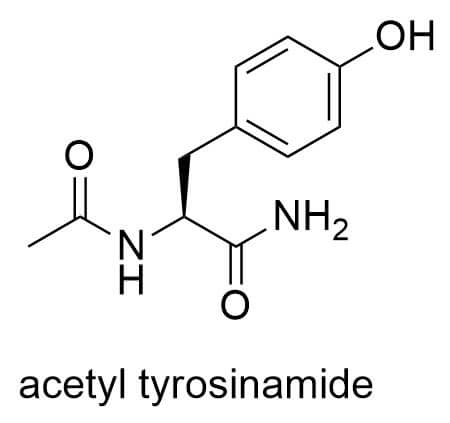
It’s been found to stimulate collagen production and increase hyaluronic acid in skin cells in vitro, and stimulate pro-collagen and GAGs in vivo.
Low Molecular Weight Hyaluronic Acid
On top of these, Neostrata Tri-Therapy Lifting Serum also has low molecular weight hyaluronic acid. Hyaluronic acid is a fantastic humectant that can hold onto water very effectively, keeping skin hydrated. It’s a large polymer so it usually doesn’t get very far into skin, but smaller versions with lower molecular weights can penetrate into the skin more deeply and hydrate skin at a deeper level. This hydration plumps skin up and makes the texture smoother.
Neostrata Skin Active Tri-Therapy Lifting Serum
Neostrata Skin Active Tri-Therapy Lifting Serum actually isn’t the first PHA product I’ve tried. I used a PHA product from Exuviance about 5 years ago, but gave up on it quite quickly since I was still in the mindset of “if it hurts it works”. It didn’t feel like it was working as much as a stinging AHA exfoliant. But this time, armed with knowledge of gluconolactone’s benefits AND lower irritation potential, I was determined to try again.
Here’s the full ingredients list of Neostrata Skin Active Tri-Therapy Lifting Serum:
Aqua/Water/Eau, PEG-8, Gluconolactone, 1,2-Hexanediol, Cyclopentasiloxane, Glycerin, Pentylene Glycol, PEG-12 Dimethicone, Polymethylsilsesquioxane, Acetyl Tyrosinamide, Cyclohexasiloxane, Hydrolyzed Sodium Hyaluronate, Dimethiconol, Biosaccharide Gum-1, Polyacrylate-13, Polyisobutene, Isopropyl Myristate, Polysorbate 20, Sodium Sulfite, BHT, Ammonium Hydroxide, Caprylyl Glycol, Xanthan Gum, Methyldihydrojasmonate, 2,6-Dimethyl-7-Octen-2-ol, Ethyl Acetoacetate, Methyl Benzodioxepinone, Phenoxyethanol, Chlorphenesin, Red 33 (CI 17200), Blue 1 (CI 42090).
It’s a slightly cloudy-looking thick serum that comes in a dropper bottle. It sinks into skin quickly, leaving a silky hydrated feeling.

The directions recommend applying 3-5 drops twice a day. After years of using alpha hydroxy acid chemical exfoliants and getting overexfoliated, I was initially a bit hesitant to use this more than once a day. But as you’d expect from the research-backed benefits of PHAs, it’s incredibly gentle, and I quickly realised using it more frequently wasn’t an issue. There’s zero stinging like you’d get from an alpha hydroxy acid product, even on chapped skin, despite it having 8% gluconolactone.
I tried this twice a day for 2 weeks. Within a few days, I saw the sorts of results I’d expect from an AHA – brighter, smoother skin tone – but with extra hydration. Even though I was using it in dry winter weather, I found that I needed less moisturiser and there wasn’t any flaking or irritation.
Have you tried PHAs? What did you think?
References
Bernstein EF, Brown DB, Schwartz MD, Kaidbey K, Ksenzenko SM, The polyhydroxy acid gluconolactone protects against ultraviolet radiation in an in vitro model of cutaneous photoaging, Dermatol Surg 2004, 30, 189-196. DOI: 10.1111/j.1524-4725.2004.30060.x
Draelos ZD, Green BA, Edison BL, An evaluation of a polyhydroxy acid skin care regimen in combination with azelaic acid 15% gel in rosacea patients, J Cosmet Dermatol 2006, 5, 23-29. DOI: 10.1111/j.1473-2165.2006.00219.x
Edison BL, Green BA, Wildnauer RH, Sigler ML, A polyhydroxy acid skin care regimen provides antiaging effects comparable to an alpha-hydroxyacid regimen, Cutis 2004, 73, 14-17.
Grimes PE, Green BA, Wildnauer RH, Edison BL, The use of polyhydroxy acids (PHAs) in photoaged skin, Cutis 2004, 3, 3-13.
Farris PK, Edison BL, Weinkauf RL, Green BA, A novel, volumizing cosmetic formulation significantly improves the appearance of target Glabellar lines, nasolabial folds, and crow’s feet in a double-blind, vehicle-controlled clinical trial, J Drugs Dermatol 2014, 13, 41-46.
This post is sponsored by Neostrata; however, the content is all based on my independent research and my honest experience. For more information, see Disclosure Policy.


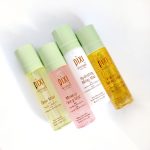
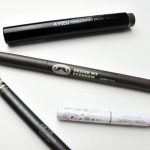

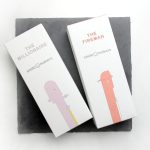
I love neostrata and want to try this serum based on your Rea search but couldn’t find an affiliate link. I want to make sure the company knows your blog helps me and that you get the credit as well. No need to post my comment if you can send me a link.
Neostrata aha is what I’ve used for years. I swear the 8oz bottle was maybe $30 US and it has lasted a lifetime. I will welcome less stinging.
Me too! I want to try this, but I want you to get credit for it. Such good research and writing!
Thank you so much! I don’t have a tracked link, but I can just show them the comment haha
I just got the PHA from Geek & Gorgeous, so can’t wait to try it out.
I have been meaning to look into PHA products as my skin doesn´t tolerate AHAs too well anymore due to the retinoid use.
Hi! Am curious if you can use this in a routine with a retinoid- not RX strength?? .Thank you!!
Yep!
I’d like to know why they have to add coloured dyes to the product? Especially red, since some people could potentially be allergic. The bottle is pretty enough without making the serum colourful.
Hi – I was wondering if you would recommend a PHA with Azelaic acid? I know you linked an article so was trying to read it but is that the best for a night time routine to help hyperpigmentation for sensitive skin? Thanks 🙂
Thanks for the great article. I’m relatively new to PHA exfoliants but are quite familiar with Neostrata products, they are fantastic and very effective!
I recently started using the PHA Bionic lotion from Neostrata, it’s a really great product, effective, lightweight, and sinks in quickly.
I am recently trying out a PHA booster from CNP Laboratory. It is around 30 USD but I got it on sale for 18 USD. It is very gentle but effective: it got rid of texture and improved overall complexion after 5 days. I am now on a full size bottle (100 ml! Huge!) and plan to incorporate it with Vitamin C in the am. Incidentally though, I was planning to try out the Rovectin Activating treatment lotion (which contains enzymes)but I assume I can’t use it with PHAs? Or peptides for that matter? Denaturation and all that. That’s actually a good idea for a video: enzymes and peptides and things they can’t be used with.